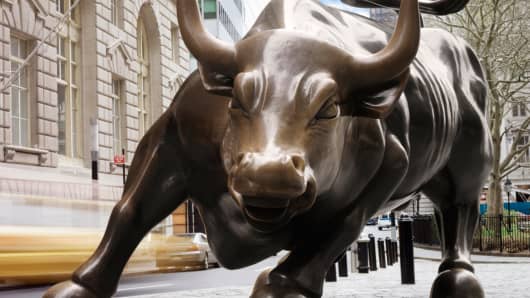Dow Industrial Average sets historic intraday high. Are we entering a new bull market?
A number of events have driven markets to new highs:
- Fed backstopping the economy
- Economy improving
- Earnings at all-time highs
- Record cash on sidelines
- No other place to put money
But longer-term, are we entering a new bull market? One that could last for several years?
There are many positive points that could argue for a rally, much of it similar to the above:
- The U.S. economy is slowly improving
- There's a ton of cheap money around, as the Fed continues to backstop the economy
- Profits are still growing, though at a slower pace compared to the last several years
- Corporate America is sitting on a record cash hoard
- Since 2008, roughly $600 billion has left stock mutual funds and $1 trillion has gone into bond funds; that's a mountain of cash that could be redeployed
Still, a sustained, multi-year bull market has plenty of headwinds. The biggest ones:
- Sub two-percent GDP growth
- Anemic topline growth that is constraining earnings growth
- Europe still in recession
- The Fed and ECB (central banks) could remove their monetary stimulus
What would get us GDP and revenue growth? I noted several weeks ago that a number of developments go a long way to improve investor confidence:
1) Clarification from Washington. The government debt-to-GDP ratio is too high. A Grand Bargain would need to encompass deficit reduction over 10 years (tax reform, entitlement reform, and discretionary spending reform in areas like defense) and an extension on the debt ceiling for, say, two years.
2) Clarification on Europe. First, the recession needs to stabilize, but beyond that policy initiatives that indicate a clear road to political, fiscal, and banking reforms, and an indication that Europe is truly serious about improving competitiveness.
3) Resumption of growth in emerging market economies, led by China.
4) The Fed successfully engineering a modest increase in interest rates without unleashing runaway inflation.
I know, tall orders. But resolution of these issues would create a huge boost to business confidence. Capital expenditures and hiring would increase dramatically, and revenues would rise.
Finally, what happens now that we are at a new high?
Arguably, the S&P 500 at a new high would be a more important breakthrough. Sam Stovall at S&P Capital IQ notes that a breakthrough there would come with its own problems: it's been very difficult to sustain new highs immediately after the highs have been set.
Stovall writes: "The S&P 500 may have little time to rejoice following the setting of a new record high before collapsing once again...."
Gee, thanks. The S&P has endured 12 bear markets (declines of 20 percent or more) since 1946. Three were "mega-meltdowns" or declines greater than 40 percent: 1973-1974, 2000-2002, and 2007-2009.
In all 12 cases, the S&P eventually got back to breakeven (it took an average of 14 months). Once that happened, however, it rose only three percent before falling back into a decline of five percent or more, and investors only had a median of two months before they slipped back into red ink.
The good news: none of the recoveries was followed by the start of a new bear market. So it's bumpy, but in no cases did the recoveries go over the cliff. At least not immediately.










